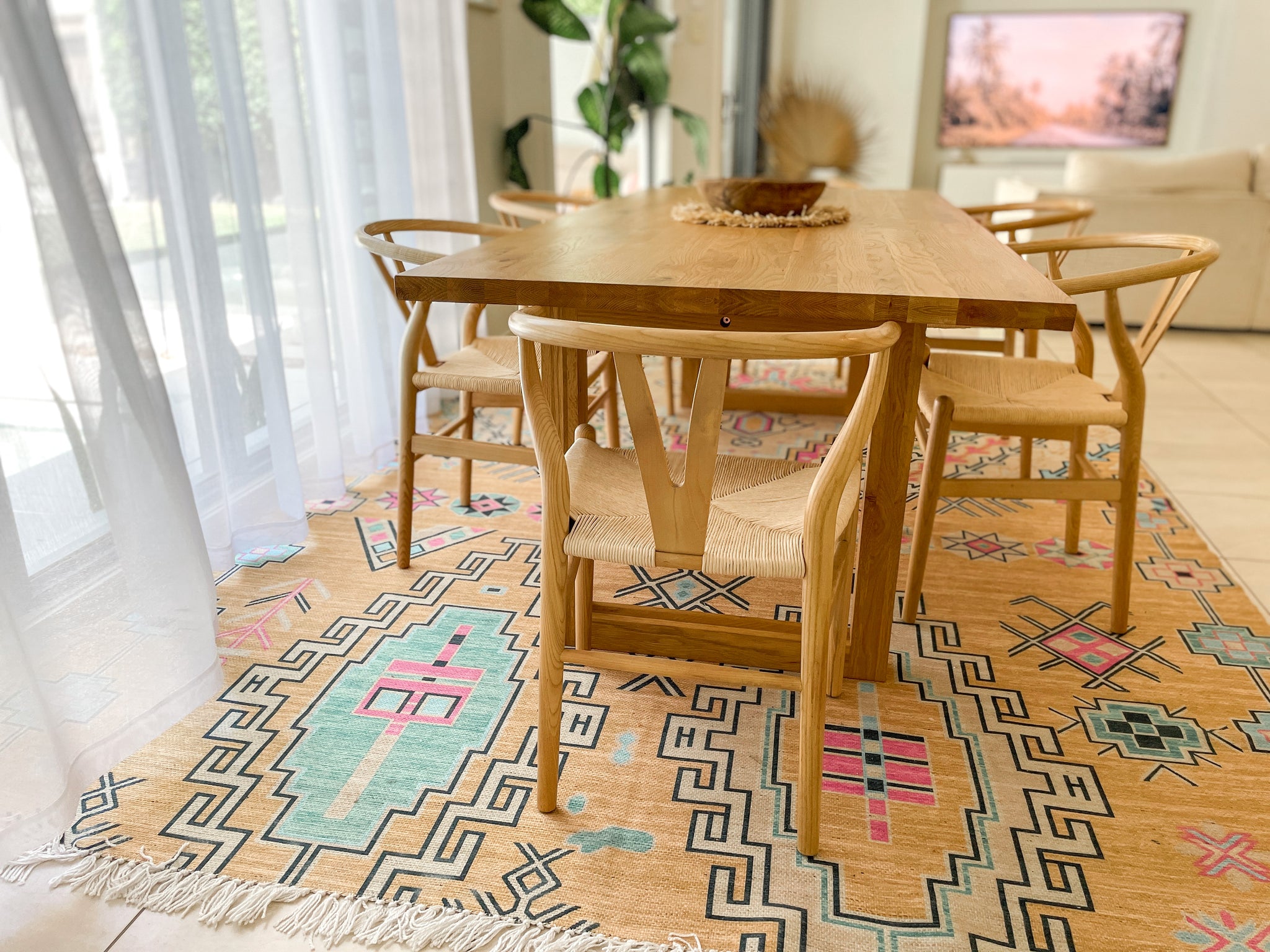
Should A Rug Be Lighter Or Darker Than Couch? Choosing The Perfect Rug Colour
Learn how to choose the perfect rug colour to create a cohesive and functional space. Consider the room's functionality, personal preferences and durability when selecting the right rug colour. Warm colours such as red, orange and yellow provide a cosy atmosphere, while cool hues like blue, green and purple create the illusion of more space.
Bold shades like electric blue or canary yellow make a statement and help complement the decor. Use a colour wheel or sample colours to select the ideal match for your space. Consider the room's lighting and its purpose to select different colour options. Remember to maintain the rug to increase longevity.
Rug Colours and Their Impact on a Room's Aesthetics
Warm Colours and Cosy Atmosphere
If you want to create a warm and inviting atmosphere, opt for a rug with warm tones such as red, orange, or yellow. The beauty of these colours is that they instantly create a cosy atmosphere, perfect for those winter nights cuddled up on your sofa. Warm colours also tend to enhance wood and other natural elements in your space. A Persian or shag rug in warm tones can add depth and richness to your living room.
Cool Colours and Visual Expansion
Cool colours such as blues, greens, and purples, are the perfect choice for creating a peaceful and calming atmosphere. These colours give a sense of space and work well in rooms that need to appear visually larger. For example, a blue rug can create the illusion of a larger living room. In addition, cool colours tend to coordinate well with metal and glass accents. A contemporary style rug in cool tones can add a modern touch to your space.
Bold Colours and Statement Pieces
If you want to make a statement, go for bold colours like electric blue, canary yellow, or fiery red. A bold, colourful rug instantly captures one's attention, so it is best to design the rest of the room around the rug. Typically, if you select a bold rug, the rest of the decor should be subdued. You do not need to play it safe with statement rugs; just ensure that they complement your style and personality.
💡KEY TAKEAWAY: Choosing the right rug colour is vital to creating the perfect ambience in your space, and by experimenting with warm, cool, or bold colours, you can achieve a sense of harmony and balance in your home decor.
Looking to learn more about rugs Melbourne-wide? We’re here to help.
Finding the Best Colour Match for Your Room
Using a colour wheel
Using a colour wheel is a helpful way to determine which colours work well together. A colour wheel shows you the relationships between different hues and can aid you in selecting colours that complement each other. A basic rule of thumb is to choose colours that are adjacent to each other on the colour wheel, such as blue and green or red and orange.
Sampling colours
Sampling colours is essential when trying to find the perfect colour match for your room. Most paint companies offer sample sizes of their paint colours, which you can use to see how a colour will look in your space. It's also a good idea to try out paint swatches in different areas of the room to see how the lighting affects the colour.
Considering the room's lighting
Speaking of lighting, considering the lighting in your room is crucial when choosing colours. Natural light can affect how a colour looks during the day, while artificial lighting can have a different effect at night. Take note of the room's orientation, as it can affect how much sunlight enters the room.
💡KEY TAKEAWAY: Use a colour wheel, sample colours, and consider the room's lighting when choosing the perfect colour for your space.
Choosing the Ideal Rug Colour for Your Room Size
Maximising small rooms with light colours
If you have a tiny space, opting for lighter-coloured rugs can be a game-changer. Light-coloured rugs can make the room appear more expansive, giving it an illusion of space and airiness. Consider using a white or pastel-coloured rug that will complement the walls to make the room feel bigger and more welcoming.
Enhancing medium rooms with warm colours
Medium-sized rooms can handle a bit more colour without feeling cramped or overbearing. Warm colours like rust, gold, and burnt orange can help enhance the cosiness of the room and inject some personality into the space. However, ensure that the colours you select do not overpower the room, so it remains inviting and comfortable.
Balancing large rooms with bold colours
Large rooms can make a statement by incorporating bold and vibrant rugs. The rug's colour should complement the room's theme and furniture, but don't be afraid to make a statement piece in a bold colour. Consider a rug with elaborate patterns or abstract designs to provide contrast to the room's minimalist elements.
💡KEY TAKEAWAY: Choosing the right rug colour according to your room size can enhance the space and create a sense of warmth and balance, making it more cohesive and stylish.
Different Colour Options Based on the Room's Purpose
Serene Shades for the Bedroom
Your bedroom should be a peaceful and calm space where you can relax and unwind. Soothing colours like soft blue, lavender, and muted green are perfect for creating a cosy and comfortable bedroom. Avoid using bold and bright shades that can promote an active environment instead of promoting relaxation.
Playful Colours for the Living Room
For the living room, let loose with playful colours. Here, you can use bold shades like orange, red, and yellow to create a vibrant and energetic space. These colours are perfect for socialising and entertaining visitors. However, make sure to combine them with neutral colours like beige, white, or grey accents to attain a harmonious balance.
Earthy Tones for the Dining Room
Earthy tones like olive green, rust, mustard yellow, and terracotta are great for the dining room. These colours help to create an inviting and warm atmosphere while fostering a sense of togetherness. Stick to darker tones if your dining area is well-lit, and balance it with lighter hues if it doesn't receive ample light.
💡KEY TAKEAWAY: While it can be overwhelming to pick colours for your home, following room-specific colour schemes can make a significant difference in creating the atmosphere you desire. Choosing the right colours can impact how the room's role is perceived and can enhance the overall harmony of your space.
Rug Maintenance and Care Tips
High-traffic areas and colour fading
High-traffic areas like hallways and entryways are more prone to dirt accumulation, leading to wear and tear. Additionally, exposure to direct sunlight can cause fading of colours in your rugs. To prevent this, you must turn your rugs every six months to avoid overexposure to sunlight. Also, consider placing rug pads underneath to minimise the impact of foot traffic.
Professional cleaning vs. DIY cleaning
While regular vacuuming can help remove dirt and dust from your rugs, it is not enough to maintain them in the long term. If you want to deep clean your rugs, consider hiring a professional rug cleaner. Professionals have specialised equipment, knowledge and expertise to handle your rugs with care - maximising their potential longevity.
However, if you decide to opt for DIY cleaning, use cleaning solutions that are safe for your rugs. Avoid using bleach or any other abrasive cleaning agents. Instead, a gentle, mild detergent will suffice. Make sure to spot-treat any stains immediately after they occur to prevent them from setting in.
Longevity and style trends
Rugs can last for decades with proper maintenance and care. Investing in high-quality rugs can make a significant difference in the longevity of your rugs. Consider styles that are multi-functional and would fit into different interior décor trends to get the most out of your rug-buying budget.
💡KEY TAKEAWAY: Proper maintenance and care are essential to keep your rugs looking their best. Consider hiring professionals for deep cleanings and investing in high-quality rugs for longevity. Turn your rugs every six months, use rug pads and avoid harsh cleaning agents to minimise wear and tear.













